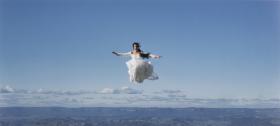Preparation
- Prepare digital cameras: ensure enough memory, working batteries, etc.
- Prepare props (if using).
Set Up
- Per small group (3–4) of students: digital camera; optional: props
Introduction/ Warm-Up
1. Begin by asking students to describe their experiences using a camera.
2. Introduce the image of flight research #5. Ask students to describe what they see when looking at this photograph. Share the title of the photograph with the students. Why do you think it is called flight research #5? What title would they give it?
3. Tell the students they are going to use a camera to take pictures of their friends moving in different ways. Brainstorm a list of ways the students can move (ex. jump, twirl, hop, skip, crawl, roll, etc.). Tell them they will work in small groups to photograph each other moving creatively.
4. Model how to use the camera safely, and demonstrate taking photographs of a child or adult moving creatively.
5. Divide students into small groups to begin taking photographs.
Focus Activity Procedure
1. Each small group (3–4 students) should have a camera and an adult supervising them.
2. Students should decide who is going to move first and who is going to take photographs. The adult supervising the small group should ensure each child has a turn to be the photographer and the subject moving. If desired, the teacher can provide props or dress-up clothes for the students to use while engaging in movement.
Closing
1. Gather the class for the closing routine, and project the photographs onto a SMARTboard or laptop for the students to view. Have students describe what movements are depicted.
2. Ask students to compare and contrast their photographs with flight research #5.
3. Ask students to look for art all around them at home and at school.
1. Observation and final photographs may be used to assess whether students were able to safely use a camera to take a photograph of another student moving.
2. Ask students to identify movements and use their bodies and vocabulary to compare them to flight research #5.
Camera
Photography
Lens
Movement words: hop, skip, jump, roll, slide, etc.
Kid-safe digital cameras with memory cards, SMARTboard or laptop computer
Optional: props or dress-up clothes for the students to use when serving as subjects
Extension Activities for Teachers
- Print out photographs and make a display or class book of the images. Allow students to write about or discuss their photographs.
- Allow students to photograph other classroom events. Use student photographs for sequencing and retelling activities.
Extension Activities for Families
- Visit a camera store or photo lab.
- Allow children to take photos on a family trip or around the house.
Suggested Books for Classroom Library
Bidner, Jenni. The Kid’s Guide to Digital Photography. Lark Books, 2004. [ISBN 978-1579906436]
Friedman, Debra. Picture This: Fun Photography and Crafts. Kids Can Press, 2003. [ISBN 978-1553370475]
A bride is suspended in the air above the boundless Australian landscape. She hovers between rising and falling, a pivotal moment in which she defies gravity. The print, although unaltered, is the result of an elaborately staged performance orchestrated by Rosemary Laing working with a stunt woman. It is part of a series of flying and soaring brides that Laing completed in the Blue Mountains, just west of Sydney. A combination of performance art and photography, the image realizes the exhilarating sense of freedom found in airborne movement and marks the liberation of the body into the beyond.
Laing poetically weds the real landscape to a seemingly unreal occurrence. Speed is captured in the quietest still as the bride levitates high above the clouds, between this world and the next. The image confounds belief; reality lies somewhere between dream and fantasy. In her white Victorian wedding gown, the bride graces the skyline like a billowing cloud in the panoramic landscape. Her gaze is intent, as if she is on a quest, alone and unafraid. Laing frames the apex of an extraordinary trajectory, an incredible instant transfixed in a single photographic image.


